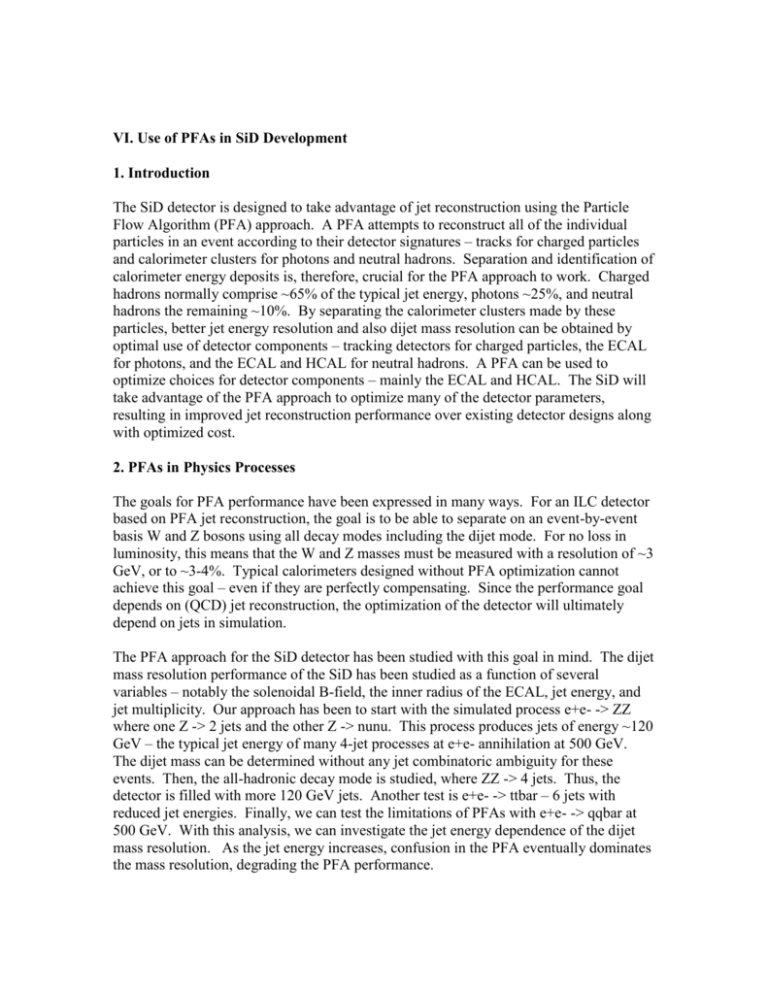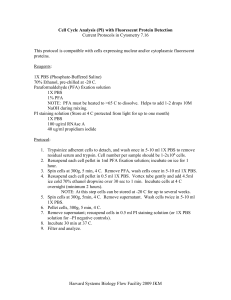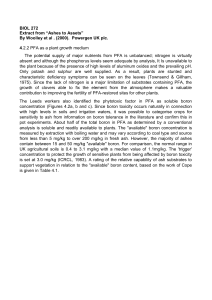Use of PFAs in SiD Development
advertisement

VI. Use of PFAs in SiD Development 1. Introduction The SiD detector is designed to take advantage of jet reconstruction using the Particle Flow Algorithm (PFA) approach. A PFA attempts to reconstruct all of the individual particles in an event according to their detector signatures – tracks for charged particles and calorimeter clusters for photons and neutral hadrons. Separation and identification of calorimeter energy deposits is, therefore, crucial for the PFA approach to work. Charged hadrons normally comprise ~65% of the typical jet energy, photons ~25%, and neutral hadrons the remaining ~10%. By separating the calorimeter clusters made by these particles, better jet energy resolution and also dijet mass resolution can be obtained by optimal use of detector components – tracking detectors for charged particles, the ECAL for photons, and the ECAL and HCAL for neutral hadrons. A PFA can be used to optimize choices for detector components – mainly the ECAL and HCAL. The SiD will take advantage of the PFA approach to optimize many of the detector parameters, resulting in improved jet reconstruction performance over existing detector designs along with optimized cost. 2. PFAs in Physics Processes The goals for PFA performance have been expressed in many ways. For an ILC detector based on PFA jet reconstruction, the goal is to be able to separate on an event-by-event basis W and Z bosons using all decay modes including the dijet mode. For no loss in luminosity, this means that the W and Z masses must be measured with a resolution of ~3 GeV, or to ~3-4%. Typical calorimeters designed without PFA optimization cannot achieve this goal – even if they are perfectly compensating. Since the performance goal depends on (QCD) jet reconstruction, the optimization of the detector will ultimately depend on jets in simulation. The PFA approach for the SiD detector has been studied with this goal in mind. The dijet mass resolution performance of the SiD has been studied as a function of several variables – notably the solenoidal B-field, the inner radius of the ECAL, jet energy, and jet multiplicity. Our approach has been to start with the simulated process e+e- -> ZZ where one Z -> 2 jets and the other Z -> nunu. This process produces jets of energy ~120 GeV – the typical jet energy of many 4-jet processes at e+e- annihilation at 500 GeV. The dijet mass can be determined without any jet combinatoric ambiguity for these events. Then, the all-hadronic decay mode is studied, where ZZ -> 4 jets. Thus, the detector is filled with more 120 GeV jets. Another test is e+e- -> ttbar – 6 jets with reduced jet energies. Finally, we can test the limitations of PFAs with e+e- -> qqbar at 500 GeV. With this analysis, we can investigate the jet energy dependence of the dijet mass resolution. As the jet energy increases, confusion in the PFA eventually dominates the mass resolution, degrading the PFA performance. 3. Tools for PFA Development To develop the PFA, several tools are needed which are common to all detector models and PFA implementations. A common basis for PFA applications is required – in particular, a common standard detector calibration is needed along with a standard Perfect PFA definition in order for useful comparisons to be made between PFA algorithms and detector models. Calorimeter Calibration A method of calorimeter calibration has been developed which could be used in a real test beam for a detector prototype. The PFA approach results in separated charged hadrons, photons, and neutral hadrons. Therefore, a full calibration should include beams of these species if possible. Neutral hadron beams are especially useful. In simulation, pions (+-), photons, and a mixture of n, nbar, and Klong are used to calibrate the ECAL and HCAL. The calibration method gives corrected energies for cheated (all hits) clusters. Additional corrections are needed for the application of real cluster algorithms, analysis techniques, etc. A standard calibration method exists and SiD variants all use this method to provide standard calibrations for detector components. Perfect PFA Definition For PFA analysis, it is important to have a standard definition of the perfect application of the PFA – no confusion in the identification of particle-cluster associations. It is especially important for the useful cases in which perfect definitions are used – for example, when perfect charged particle tracks are used to test the PFA performance in the calorimeter only. When used with the standard detector calibration procedure, resolutions of individual particle energy distributions match those of the particles used in the calibration method. The Perfect PFA provides a check not only of the optimal PFA performance, but also a check of the calorimeter calibration method. Cluster Algorithms Many cluster algorithms have been developed for use in PFAs. More importantly, most of these have standardized inputs and outputs, so easy evaluation and comparison of multiple cluster algorithms can be done. Procedures exist to illustrate purity and efficiency of cluster algorithms, so that optimal choice can be made of algorithms to use in various stages of the PFA. For example, when choosing a cluster algorithm for trackcluster matching, overall purity performance is preferred over efficiency, while for photons, a more balanced performance is desired. 4. PFA Approaches for SiD Several PFA approaches have been investigated for the ILC detector concepts. These can be divided into basically 2 types – a modular approach designed to perform particle identification and separation with methods optimized for each particle species, and cluster algorithm approaches where a specific cluster algorithm is used to define all particle clusters in the calorimeter. One approach to PFA development is to use an optimized single cluster algorithm to try to form clusters of all particles in the event. These cluster algorithms must be able to reconstruct clusters of many varied types – mips, electromagnetic showers (photons and electrons), and hadronic showers (both neutral and charged). Cluster algorithms based on hit density, fragment distances, and shower shapes have been developed for this type of PFA. Another approach is to develop individual algorithms optimized for the particular particle being tested. This type of PFA has a natural modular structure with each step consisting of a cluster algorithm and topological evaluation algorithms optimized for a particular particle species. The modular structure allows easy comparisons to be made at each stage and for fast identification of PFA performance. 5. PFA Results The following plots show results for application of a PFA on single particle species. The ultimate performance limit of the PFA can be illustrated for each type of particle in this way and estimates of the minimum confusion introduced by the PFA can be made. Plots for charged hadrons (pions), photons, and neutral hadrons here. Single Particle PFA Response Charged Hadron/Cluster Association Photon Algorithm Performance Neutral Hadron Algorithms Initially, PFAs were developed using simulated e+e- -> Z production at the Z pole (91.5 GeV). No jet algorithms were needed and the PFA performance could be shown as an energy sum. Since there is no ambiguity in the choice of jets used in the dijet mass calculation, the dijet mass resolution and the energy sum resolution are ~equal for these events. Plots for ZPole performance of PFA if any. PFA Results for Total Energy Sum at ZPole The dijet mass is the most important result of PFA performance for the e+e- collider at 500 GeV CM. Dijet results are shown here for events with 2 jets, 4 jets, and 6 jets at 500 GeV CM. When plotted as a function of jet energy, the increasing contribution of confusion in the real PFA is seen. Dijet Results @500 GeV vs jet energy 6. Future SiD Optimization with PFAs Based on the performance obtained so far, PFAs will be used to optimize several parameters of the SiD detector, helping to choose these parameters for the final SiD design. In particular, the PFA performance can be used to evaluate various choices of inner radius (distance from IP to inner face of ECAL), and B-field (central solenoidal field strength). Along with the cost parameters, the PFA can then be used to optimize the size of the SiD detector. Also, various technologies for an optimized HCAL can be tested with PFA applications. For example, the PFA performance of analog scintillator designs can be compared to digital gas calorimeters. Some plots illustrating beginning studies of these things here. IR B-Field (H)CAL Technology









